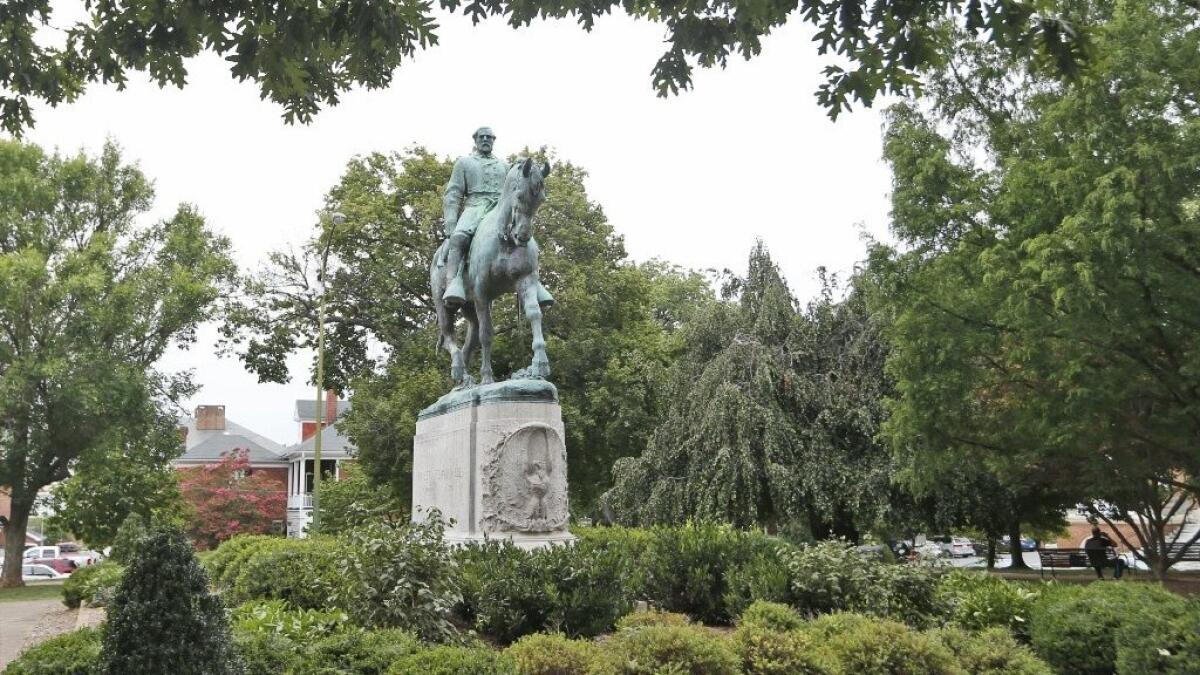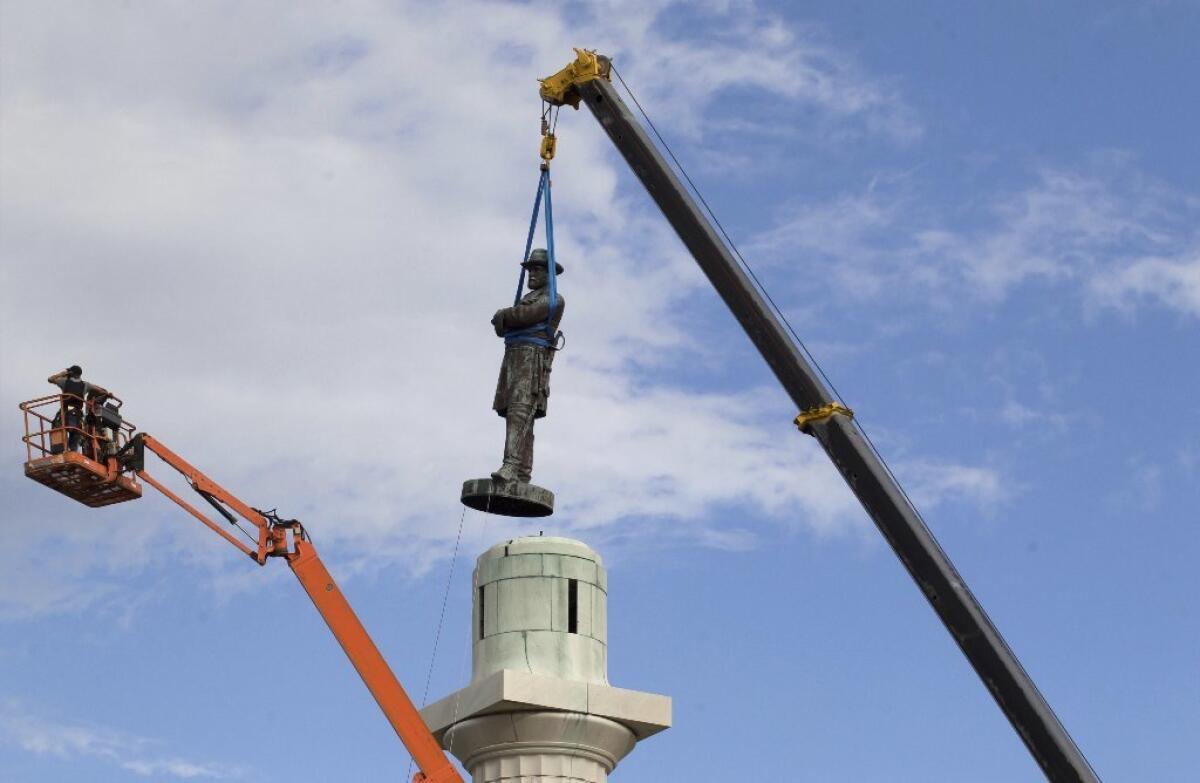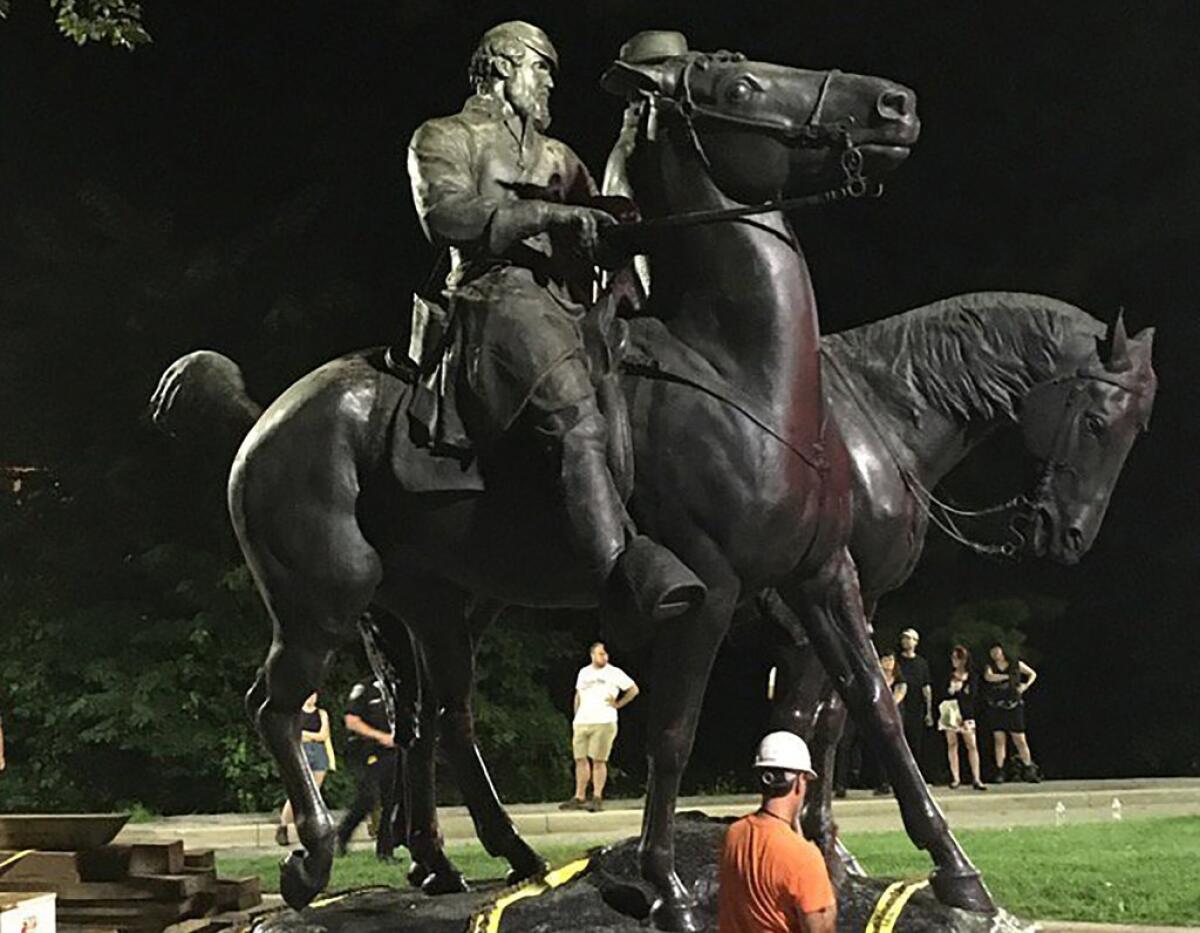Perspective: What to do with Confederate monuments? Put them in museums as examples of ugly history, not civic pride

Confederate monuments are being taken down across the United States, sometimes with fanfare, sometimes in the dead of night, sometimes with agonizing bloodshed.
The argument is over a specific kind of art, and I don’t mean sculpture. The argument is over civic monuments.
Louisiana, Virginia, Maryland — in these places the elimination of Confederate monuments cannot happen soon enough. Some claim that removing them erases history. That’s backward. Erecting them does.
Some claim that removing [Confederate monuments] erases history. That’s backward. Erecting them does.
Take the statue of Gen. Robert E. Lee in Charlottesville, Va. Its planned removal erupted last week into violent, white supremacist domestic terrorism. Henry Shrady, the artist, was a talented but largely self-taught sculptor. (When he died before finishing the statue, Leo Lentelli completed it according to Shrady’s designs.) As a fitting bookend, Shrady also was the sculptor for the colossal statue of Gen. Ulysses S. Grant, Lee’s nemesis, that stands in front of the U.S. Capitol. Dedicated two weeks after the artist’s death in 1922, the mammoth Washington, D.C., project took 20 years.
Both are equestrian statues, the magnificent, muscular horses aggrandizing their riders through the soldiers’ partnership with — and control of — a powerful force of nature. The conventional artistic motif of an equestrian figure goes back at least as far as ancient Greece, and it signifies a man (rarely a woman) whom the society regards as an unalloyed hero.
An equestrian statue of Ulysses S. Grant, yes; of Robert E. Lee, no.
Grant was a notorious drunk, but he led the Army that preserved the Union in the ghastly Civil War. Lee was a remarkably gifted general, but he was also a traitor. (A bias: My great-grandfather, along with tens of thousands of others, helped foil Lee at Gettysburg in 1863, turning around the war for the Union.) Art aims for truth, while kitsch is the cheery aesthetic embodiment of a lie. The Lee monument is kitsch.
I wouldn’t call Shrady’s impressive Grant monument a masterpiece, given its tired stylistic naturalism during the artistically ambitious first decades of the 20th century. But Shrady’s deftly manipulated bronze in Virginia regales us with something sordid. Worse, it demands respect for fallacy.
History is complex, but the Lee monument sanitizes the past. Lee saw himself as “Hannibal’s ghost,” in Civil War historian Michael Fellman’s incisive words — as a brilliant tactician ultimately thwarted. The grandiosity of his equestrian monument rings false as a portrait.
Indeed, that grandiosity more accurately reflects motives in the era of the commission. Shortly before the Lee monument was contracted, D.W. Griffith’s silent 1915 epic, “The Birth of a Nation,” had marshaled technical innovation to portray the Ku Klux Klan as a heroic force. That was a lie, too; the film was a hit.
It is likely, at least in part, that Shrady got the Lee commission in 1917 because he was already 15 years into working on the elaborate Grant monument in Washington. Investment banker and philanthropist Paul Goodloe McIntire, who also endowed the first chair of fine arts at the University of Virginia (the art department there is named for him), paid for it.
Like many Confederate monuments, the Charlottesville statue dates to a period after the First World War when racist Jim Crow laws were being amped up in America. New Orleans Mayor Mitch Landrieu, in a smart, widely praised speech in May explaining why his city removed its major Confederate monuments from their civic pedestals, minced no words: They “were erected purposefully to send a strong message to all who walked in their shadow who was still in charge.”
It’s statuary as intimidation. Together, Shrady’s Lee monument in Virginia and his Grant monument in Washington create a false equivalence in bronze.


Likewise, that the issue is coming to a head now reflects current social stresses. In the wake of the popular presidency of
No wonder he wants to keep Confederate monuments intact. But they need to be taken down.
Early one morning in 1992, I was suddenly awakened from a jet-lagged sleep in my Art Nouveau extravaganza of a Budapest hotel by an awful, clanging racket. Stumbling to the window, I peered out into the morning light to watch Hungarian workers with jackhammers going at it: A big five-pointed red star, a monument to Communism, was being dismantled from the small square in front of the hotel. It was gone by the end of the day.
I later learned that the hotel had recently passed from government to private ownership. In newly post-Communist Hungary, a red-star monument out front was bad for business — or at least bad for appearances.
Plans were also underway to move monumental Communist-era sculptures from all over the city to an open-air museum in a park — a museum about dictatorship, as the project architect, Ákos Eleőd, explained, since “only democracy is able to give the opportunity to let us think freely about dictatorship.”
Memento Park opened to the public the following year. It’s now a popular tourist attraction of historical gravity and artistic kitsch.
In the wake of the controversy over removing American monuments to the Cult of the Lost Cause of the Confederacy, Memento Park is not a bad model for us to consider following now — although certainly there are others. The dispute, which exploded into bloodshed, death and grinding national shame in recent days, demands hard thought. Decisions need to be made.
Unlike sculpture, civic monuments are less the product of an individual artist than they are collaborations of entire societies. Civic monuments solicit a collective moral response. They invite an audience to affirm and applaud what it sees.
Confederate monuments, like their Communist bronze and granite comrades in Budapest, are kitsch. Naturalistic skill in modeling, casting and carving are only the most rudimentary signs of artistic merit.
At least 700 have been identified across the country. What to do with them when they’re removed?
Confederate cemeteries are one answer. Decorating the graves of fallen soldiers on both sides of the Civil War evolved into Memorial Day, a federal holiday. The indecent monuments deserve a decent burial.
History museums, whether in the style of Budapest’s Memento Park or another format, are another solution. The monuments demand explanation.
History museums can provide not just the truthful context of the Civil War, but of the self-satisfied civic eruption of Confederate monuments after Plessy vs. Ferguson, the disastrous 1896 Supreme Court ruling that upheld “separate but equal” racial segregation. The ruling’s collapse in 1954’s Brown vs. Board of Education decision saw a second, this time bitter burst of Confederate monument building.
And, yes, many should just be bulldozed or melted down. They are history’s rubble.
Given events in Charlottesville, perhaps that statue of Lee deserves special handling. Make it a turning point in a story of bullying inequality that has gone on far too long. Truck Shrady’s statue 70 miles down the road to Appomattox Court House National Historical Park, where the bronze equestrian figure could be taken off its granite pedestal and displayed beside it, dethroned and defanged.
It’s sad that the site of the general’s surrender to Grant, meant to mark the end of the Civil War, needs to be called into service again. But it would be a proper resting place for the ugly history of America’s Confederate monuments.
christopher.knight@latimes.com
Twitter: @KnightLAT
ART REVIEWS:
Is that a laugh? A cry? In Ben Jackel's sculpture, messages molded by deft hands
'Dennis Hopper: The Lost Album' buoyed by photos with cinematic insight
The biggest entertainment stories
Get our big stories about Hollywood, film, television, music, arts, culture and more right in your inbox as soon as they publish.
You may occasionally receive promotional content from the Los Angeles Times.








